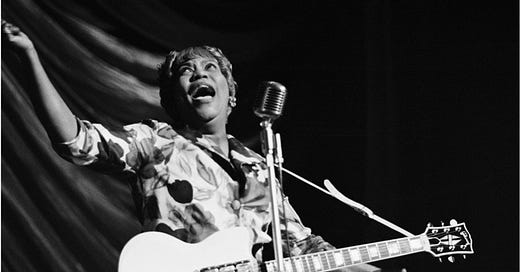Sister Rosetta Tharpe (Part 2)
Try to set aside an hour to watch this series of clips. Seriously. They are riveting.
After writing the previous post, I stumbled across a one-hour BBC documentary on Sister Rosetta that was aired in 2014. It is a remarkable piece of work, and far more comprehensive than my modest bit of research. There are some contradictions between my sources and this documentary, which is not surprising, given the spotty records of her early life. The references to the rock stars who were among her fans in the 1960’s are not mentioned in the documentary but appear to be accurate, based on other sources.
After peaking in the late 1940’s and early 1950’s, Sister Rosetta Tharpe faded from view in the U.S. However, she experienced a revival of her fortunes in the early 1960’s, when audiences in the U.K. and Europe discovered her. She never did regain her star status in the U.S., for a variety of reasons including the rise of white rock and roll musicians. It took the efforts of British archivists and documentarians to give her proper recognition for her achievements. She was finally inducted into the Rock and Roll Hall of Fame in 2018, 45 years after her death.
The following clips break up the documentary into four roughly equal parts. Get your popcorn and settle in--I could not stop watching once I started.
Part 1 starts with a snapshot of Sister Rosetta at the time she was emerging as a star. It then goes back into her childhood and teen years, until her first marriage at the age of 19. Later research contradicts some of the details in this documentary, such as her and her parents’ legal names, but that is not unusual for poor Blacks in the post-reconstruction South, who were still treated as less than full people. (Note: some of the footage is of generic scenes of historically Black communities, overlaid with audio recordings from that era, not necessarily of Sister Rosetta.)
________
Part 2: Sister Rosetta navigates the fine line between keeping her Gospel audience and building a secular fan base, not without controversy. More challenging, she breaks the color line, performing with white musicians when mixed performing groups were taboo. She becomes a national star, with a fanbase crossing racial lines. (Again, some sources differ in particulars, but the overall story is consistent; as before, some of the urban scenes are generic newsreel footage.)
_______
Part 3: Sister Rosetta reaches her peak popularity in the late 1940’s, while dealing with serial relationship disappointments. She partners with Marie Knight, and they make several hit records together. They also have a romantic relationship lasting five years, which would itself have been a big scandal if it had been generally known. In 1951, she marries for the third time, in a ceremony held in a stadium before 25,000 fans. Meanwhile, rock and roll played mostly by white boys is beginning to take off, and her audience is about to move on.
_______
Part 4: Sister Rosetta’s career has a revival, when British musicians invite her to tour Europe and England with them. From 1957 through the mid 1960s, she performs for adoring audiences including many of the musicians who would go on to become rock gods (other sources list Eric Clapton, Jeff Beck, Brian Jones and Keith Richards as among the emerging superstars who attended the “railway station” performance outside Manchester). Diagnosed with diabetes, she begins to suffer failing health. She dies in 1973 after a series of strokes, at the age of 58. The footage of her last known recorded concert, in 1970, is unbelievably moving.



